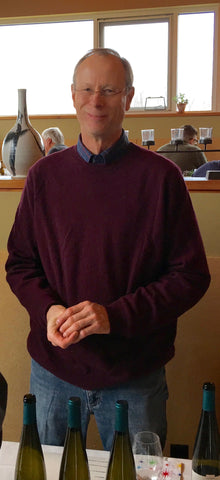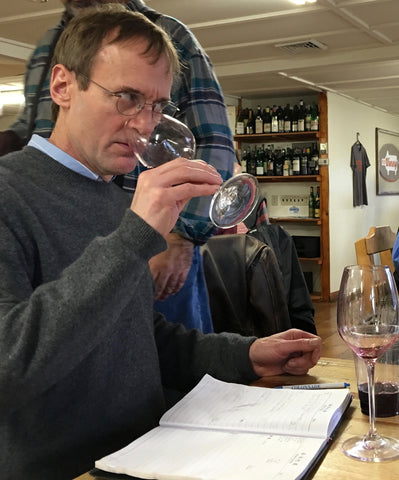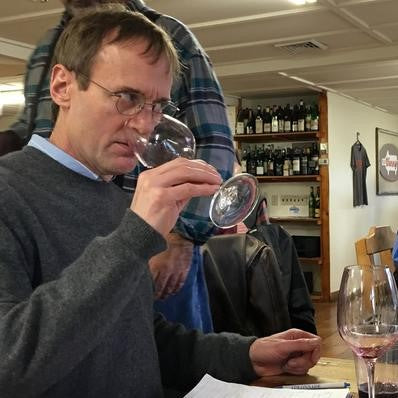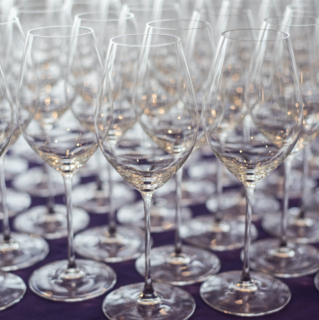by David Furer
Michigan’s ‘2 Peninsulas’ is a firm second place but for cool climate, aromatic whites, no US region beats New York's Finger Lakes (FLX)--with its sparkling wines and Cabernet Francs also to be reckoned with.
Vinifera first succeeded here with the Ukrainian-German immigrant (one quarter of your author’s bloodline, too) Dr. Konstantin Frank in the 1950s at the FLX’s Gold Seal Vineyards. The ‘German Connection’ continued with winemaking scion Hermann J. Wiemer arriving in the 1960s for work, soon leaving the hybrid- and labrusca-dominated winery with which he was associated to strike out on his own. Sourcing his vine material from Europe, Wiemer expanded his holdings to what's now 80 acres under the ownership of winemaker Fred Merwath and director Oscar Bynke. "It's all about Riesling at Wiemer," assured Bynke, which accounts for the majority of sales. Enormous minerality derived from these shale-based soils shine throughout the range of its single-varietal whites, Champagne-style bubblies and, were it not for a wee heavy-handed in its use of Hungarian oak—an otherwise toothsome Cabernet Franc from their Magdalena vineyard.
Sparkling wines have been made since 1985, and from which Wiemer had been growing Pinot Noir and Chardonnay specifically for the production of bubblies. “His motivation came from the cool climate of the Finger Lakes’ cooler vintages, allowing the warmer vintages to make still wines,” said tasting room manager Jeremy Coffey. Its 100% Pinot Noir Blanc de Noirs quickly sells out, but not before I was treated to its autolysis-driven aroma of burnt rubber and sweat, medium-full body, delicately tannic structure, long and slightly warm finish derived from 54 months left on the lees. All still whites are spontaneously fermented with the trend for the reds to soon do the same.
A Wiemer alumni and recent associate of mine (shameless plug!), Dan Belmont, has for two years directed the events & classes program at Manhattan’s Murray’s Cheese yet still finds time & pleasure in returning both to promote cheese and taste wine.
Fred Frank, grandson of the eponymous founder of Dr. Konstantin Frank winery, was working for the renowned Banfi Vintners in 1993 when, with his father Willi ailing, he took hold of the family estate, carefully growing it to become what's arguably the finest vinous operation east of the Mississippi River. He and his cousin grow at the 'banana belt' of Seneca Lake along with Cayuga Lake. Guest winemakers hailing from Germany, France, Australia, and California make this one of the most broadly-scoped teams I've encountered, one ably augmented by Fred’s sister Barbara overseeing the family’s sparkling wine production (my fave’s the Riesling). The Frank family nursery supplies many east coast wineries while its long & minerally Rieslings, Gewurztraminers, Gruner Veltliner, and a rightly heralded Rkatsiteli appear on many of New York City’s best wine lists. Frank's whites are tops for near- to mid- term drinking with the odd bottle aging well beyond a decade. And in this light Fred’s daughter Meaghan exercises her part in determining what will surely be a future as rosy as their Celebre bubbly of the same hue.

Mark Wagner’s ancestors began growing grapes and other fruits along Seneca Lake’s east side since the 1880s. Early in his career Mark was selling the majority of his produce to neighbor wineries, which he continues to do in small part, but came into his own in 1990 with his dramatic Neo-Greek revival Lamoreaux Landing winery near the venerable family estate. My sometime host and fellow BMW motorcycle enthusiast enjoyed with me a sunny & windy January lunch where his latest Brut bubbly, a 2009 made from a 40/60 ration of Pinot Noir and Chardonnay all grown on and vinified from his 105 acres, reeked of yeast and sweet apple showing consistent and intense perlage with a clean malic acid character. He thinks the 2009 vintage as typical—reds a little late and a little less ripe with the whites the main supporter of what he says “was a good sparkling year.” Bubblies—with low production and low demand allow for disgorging on demand, commonplace in FLX, a factor which allows producers to adjust the dosage as needed. Fruit-forwardness in all FLX bubblies is a regional characteristic.
For Wagner, the FLX wine game has been considerably upped since he started. “We’ve very few people that come in with a lot of money. We can still make world-class wine without having a lot of capital. But the spring-to-autumn tourism traffic has been phenomenal, and people are knowing our wines before arriving. Within six miles of where I grew up there are now six great restaurants compared to a just over a decade ago only having a burger & ice cream joint!”
Wagner also makes a Chardonnay Blanc de Blancs, and has been working with Gruner Veltliner as a still wine for five years. Though others tout Pinot Noir he thinks Cabernet Franc the way forward for still reds in this area of gravelly, silt-loam soils. “We tried a still Pinot for years as our flagship red, beating myself up on it with it in liking them one day and not the next. It’s the perfect grape for sparkling wine here, but not the best for the area overall.” No matter as his Rieslings, especially that from Round Rock vineyard, are consistently dynamic and age worthy.
My introduction to these Glenora wines wasn’t at the pre-appointed time at the winery but rather at the village of Geneva’s ‘wining’ hole of Microclimate where Bob Madill, formerly of Sheldrake Point Winery, treated me and others (including Geneva resident Sophie Paillard of Champagne fame and Microclimate’s owner Stephaine Mira de Orduna of France) to a sparkling 1991 Pinot Noir Rose which was holding up surprisingly well. Glenora is also connected to the Knapp Winery for which it’s producing some fine, youthful Cabernet Franc. “The future of the Finger Lakes is in making slightly better wine at a slightly better price,” affirmed Madill. “We don’t need to sell wines at $40/btl. to make a living.”
Glenora’s winemaker Steve DiFrancesco has been in FLX since 1979, making him the elder statesmen of its winemakers. “In the ‘80s we had two hot & dry vintages, in the ‘90s and ‘00s it increased to four each, yet we still have cold & wet vintages, so the hair-splitting that goes on between the quality of the east or west side of Seneca Lake is relevant,” he said. Glenora buys grapes from 14 growers in the Keuka, Seneca, and Cayuga lake areas, something DiFrancesco likens to Champagne vignerons’ ability to source from a wide variety of regional sources. “But we also have single-vineyard Rieslings,” made from its 140 acres and contracts with 14 outside growers.
Until the original partners fell on hard times, Glenora had a reputation for being the best sparkling wine producer on the East Coast accounting for 18% of its production whereas now it represents 7%. Its 2006 Brut from purchased Seneca Lake fruit spent seven years on the lees, and was less aromatic than I expected, well-integrated with some concentration of Golden Delicious apple, a good balance, and a vinous finish. As impressive is a concrete egg—fermented Pinot Blanc sporting a restrained nose and integrated palate; clear and clean, nearly elegant, with a slightly warm and long finish.

Overseeing production at Fox Run Winery is Peter Bell who, though producing sparkling wines since the starting his career in the early ‘90s at Frank winery and previously while studying in Australia and New Zealand, began our visit lamenting the quality control problems he’d been having with his sparkling wines—one of which sent him to hospital to get six stitches sewn into his right hand! That said, Bell’s sold out of his 2011 Blanc de Blancs and over a cold lunch of locally-made pate and breads at Fox Run’s on-site cafe I asked him about his preferences. “I want straightforward varietal expression so I’m not keen on spontaneous fermentations.” Reflective of this is the Fox Run house style; rather commercial via its tendency towards more oak than is necessary—in my opinion—though still executed with care and skill.
“It should be an important part of our production and we ought to be a noticeable second or third tier producer of sparkling wines of the world,” said Bell. “But it never happened because the market wasn’t willing to sop up any quantity of the style. Our cost of production is too high to compete with Penedes or Prosecco.” The ease of sales and economics work better for him with fortified wines than sparklers. As with others here he views European export sales as “bringing coals to Newcastle” but assured me that Belgians have been very open-minded about his wines with restaurateurs ensuring he sells two palates of wine into Benelux annually. “Cabernet Franc has been successful, the Chardonnay is in a universal style acceptable to many tastes.”
Tooting the horn of fellow scribes is something I do rarely; but when it comes deeper insight into the FLX, plus all things ‘Riesling’, I urge you to click onto
http://www.stuartpigott.com.
 Mark Wagner’s ancestors began growing grapes and other fruits along Seneca Lake’s east side since the 1880s. Early in his career Mark was selling the majority of his produce to neighbor wineries, which he continues to do in small part, but came into his own in 1990 with his dramatic Neo-Greek revival Lamoreaux Landing winery near the venerable family estate. My sometime host and fellow BMW motorcycle enthusiast enjoyed with me a sunny & windy January lunch where his latest Brut bubbly, a 2009 made from a 40/60 ration of Pinot Noir and Chardonnay all grown on and vinified from his 105 acres, reeked of yeast and sweet apple showing consistent and intense perlage with a clean malic acid character. He thinks the 2009 vintage as typical—reds a little late and a little less ripe with the whites the main supporter of what he says “was a good sparkling year.” Bubblies—with low production and low demand allow for disgorging on demand, commonplace in FLX, a factor which allows producers to adjust the dosage as needed. Fruit-forwardness in all FLX bubblies is a regional characteristic.
Mark Wagner’s ancestors began growing grapes and other fruits along Seneca Lake’s east side since the 1880s. Early in his career Mark was selling the majority of his produce to neighbor wineries, which he continues to do in small part, but came into his own in 1990 with his dramatic Neo-Greek revival Lamoreaux Landing winery near the venerable family estate. My sometime host and fellow BMW motorcycle enthusiast enjoyed with me a sunny & windy January lunch where his latest Brut bubbly, a 2009 made from a 40/60 ration of Pinot Noir and Chardonnay all grown on and vinified from his 105 acres, reeked of yeast and sweet apple showing consistent and intense perlage with a clean malic acid character. He thinks the 2009 vintage as typical—reds a little late and a little less ripe with the whites the main supporter of what he says “was a good sparkling year.” Bubblies—with low production and low demand allow for disgorging on demand, commonplace in FLX, a factor which allows producers to adjust the dosage as needed. Fruit-forwardness in all FLX bubblies is a regional characteristic. Overseeing production at Fox Run Winery is Peter Bell who, though producing sparkling wines since the starting his career in the early ‘90s at Frank winery and previously while studying in Australia and New Zealand, began our visit lamenting the quality control problems he’d been having with his sparkling wines—one of which sent him to hospital to get six stitches sewn into his right hand! That said, Bell’s sold out of his 2011 Blanc de Blancs and over a cold lunch of locally-made pate and breads at Fox Run’s on-site cafe I asked him about his preferences. “I want straightforward varietal expression so I’m not keen on spontaneous fermentations.” Reflective of this is the Fox Run house style; rather commercial via its tendency towards more oak than is necessary—in my opinion—though still executed with care and skill.
Overseeing production at Fox Run Winery is Peter Bell who, though producing sparkling wines since the starting his career in the early ‘90s at Frank winery and previously while studying in Australia and New Zealand, began our visit lamenting the quality control problems he’d been having with his sparkling wines—one of which sent him to hospital to get six stitches sewn into his right hand! That said, Bell’s sold out of his 2011 Blanc de Blancs and over a cold lunch of locally-made pate and breads at Fox Run’s on-site cafe I asked him about his preferences. “I want straightforward varietal expression so I’m not keen on spontaneous fermentations.” Reflective of this is the Fox Run house style; rather commercial via its tendency towards more oak than is necessary—in my opinion—though still executed with care and skill.

